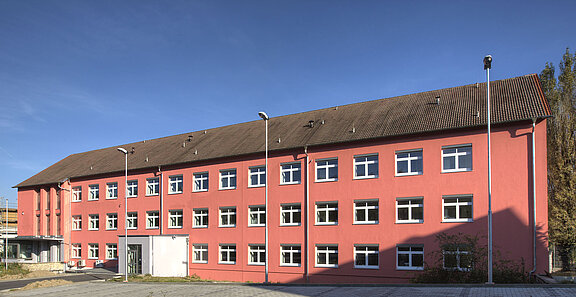

Veterinary research on bacterial animal diseases has been conducted in Jena for more than 50 years. On July 1, 1954, Victor Goerttler founded the Institute for Bacterial Animal Disease Research (ITSF) of the German Academy of Agricultural Sciences. The first director also was professor and dean of the Agricultural Faculty of the Friedrich-Schiller-University Jena and director of the veterinary investigation and animal health agency of the state of Thuringia.
As intensive research on the at that time important infectious diseases of farm animals required a capacity increase of manpower and facilities, Goerttler already began to campaign for the establishment of new buildings for the ITSF in Jena-Zwätzen in the late 1950s. The new buildings on the premises still used today were put into operation in 1961/62 and offered a generous amount of space, well-equipped laboratories and modern facilities for study animal husbandry.
The structure of the institution was adapted repeatedly to the increasing requirements imposed by scientific progress as well as by the needs of veterinary practice. In addition to departments and specialized groups for the fields of basic research with their respective methods such as serology, virology, mycology, pathology and histology (including electron microscopy), pathophysiology, immunology and biochemistry, the institute also had departments for radiochemistry, molecular biology/genetic engineering, cell and tissue cultivation and biostatistics, which were responsible for the introduction of specific investigation methods. A number of specialized departments were also founded for newly arising major research topics such as tuberculosis, reproductive disorders, mycoplasma infections, food and milk hygiene. The main focus was always put on the availability of a large variety of methods to approach upcoming problems from various sides. One strength of the ITSF was that it always united representants of a variety of disciplines (veterinarians, chemists, physicists, biologists, farmers) who were able to elaborate complex solutions.
The fall of the wall and the reunification of Germany marked a decisive break for the Jena institute. Like all scientific institutions of the former GDR, the ITSF Jena was evaluated by the Scientific Council (May 29, 1991). The latter recommended to transform the ITSF into a federal research institute for bacterial animal diseases and zoonoses within the portfolio of the Federal Ministry of Health (BMG). Finally, the institution was incorporated on January 1, 1992 into the Institute of Veterinary Medicine (Robert von Ostertag-Institut) of the Federal Health Agency as Department of “Bacterial Animal Diseases and Zoonosis Control”. After the liquidation of the Federal Health Agency, the entire staff was taken over by the newly founded Federal Institute for Consumer Health Protection and Veterinary Medicine (BgVV) (from July 1, 1994 to October 31, 2002). During this time Horst Meyer (1990 to 1997) and Dietrich Schimmel (1997 to 2002) were head of the institute/department.
When in November 2002 the institute was incorporated into the Federal Research Centre for Virus Diseases of Animals (BFAV) it kept most of its traditional areas of work. In addition, the institute increasingly focused on research projects in association with upcoming problems and established new laboratory methods. Today, a series of important zoonoses, such as e.g. salmonellosis, campylobacteriosis, tuberculosis and chlamydioses, count among the major research fields of the institute.
The central task of the Jena institutes (Institute of Bacterial Infections and Zoonoses and Institute of Molecular Pathogenesis) remains to conduct research on the etiology, pathogenesis, diagnostics and epidemiology of bacterial animal diseases. To fulfil these tasks, modern laboratory methods are combined with a solid basis of animal studies. Research results are used for the control of these diseases with the aim to establish healthy animal holdings as basis for the production of high-quality and safe food products.

